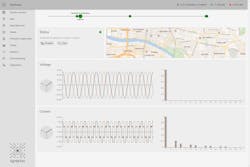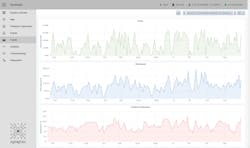Building Resilience and Secure Automation into Transmission and Distribution Systems
In August 2019, the Great Britain (GB) national transmission system operated by National Grid suffered a very rare event. It required activation of emergency load shedding, disconnecting supplies to one in 10 customers in order to save the wider transmission system. This outage was caused by a complex series of events starting with power oscillations that coincided with a lightning strike and protection trip, causing the control systems embedded in an offshore wind farm to oscillate further and then unexpectedly trip 737 MW of wind generation. This was then followed by a second major generator failure, all of which was superimposed with large-scale distributed energy resources, as required by the Grid Code. The system frequency rapidly plummeted below the specified lower limit so emergency load disconnection was activated, tripping the supply to about 1.1 million customers. Therefore, this major event caused wide-scale disruption to busy commuter trains, hospitals and airports.
Low-frequency oscillations in the transmission system were evident 10 minutes before the lightning strike. Hence, this event is a strong warning signal of impending wider stability issues that can emerge because of the proliferation of grid-connected power electronic converters. Research in the UK has highlighted how “weakening” of the transmission system grid can lead to critical instabilities during periods of very high level non-synchronous generation. The lack of monitoring and control at the “extremities” of the system, where approximately 37 GW of distributed generation is already connected, also limits the capability of system operators to manage the transmission system that, in GB, has a peak demand of 59 GW. A number of similar unexpected situations could occur in the future, yet the industry presently only has relatively crude tools to identify and respond to such disturbances. Insights into subtle operational deviations over time are needed instead. Therefore, it is critical to be able to perform quick and efficient post-event analysis to pinpoint the location and the cause of the incident. This requires near-instant access to accurate, time-synchronized data over a wide area of the transmission system.
The abundance of power electronic-interfaced generation and HVDC interconnectors has another side effect — it warrants closer monitoring of system harmonics and inter-harmonics. In particular, the UK guidance for new transmission and distribution connections [Electricity Network Associations (ENA) Engineering Recommendation G5, June 2020] recommends sensitivity measurements up to and including the 100th harmonic frequency at transmission or distribution system connection points. This more recent development requires suitable measurement transducers and capable monitoring systems. These are difficult problems to solve and they require joint innovation in both secondary hardware and software systems.
Investing in Hardware Capabilities for the Long Term
The first stage is to deploy suitable instrumentation to digitize the state of the system and investment in secure communications to transmit the data where it is needed without undue delay. Many system operators worldwide have synchrophasor networks — typically for the transmission level — that are generally being used to provide visualization and retrospective, offline analysis. However, even advanced synchrophasor systems can 'miss' sub-cycle transients and they have deliberate filtering to remove out-of-band frequencies. However, these hidden signals may correspond to critical oscillations, as was the case prior to the GB 2019 partial blackout.
To address these major industry needs now, and for the future, new tools are emerging to provide sample-by-sample waveforms of voltages and currents, which go well beyond the capabilities of conventional synchrophasor or supervisory control and data acquisition (SCADA)-based measurements that provide two or three orders of magnitude more detail. This is similar to having networked fault recorders, with the data readily available to users in real time. Until recently, this has not been possible to achieve cost-effectively.
This approach, which has been dubbed continuous point-on-wave (CPOW), is critical for understanding and diagnosing some events which are 'hidden' in relatively coarse synchrophasor or SCADA data. For example, transients during switching events or electrical faults, which may include stressful electrical arcing, could be detected and logged within the condition monitoring profile of assets, such as circuit breakers. The entire transient may simply be unobservable using synchrophasor data.
Distributed Electro-mechanical Sensing
Distributed electro-mechanical sensing (DES) is a new approach for instrumenting wide areas of electrical networks, without any compromise in measurement quality, but at a cost that is very low compared with conventional methods. This involves coupling multiple sensors, including those for voltage, current, temperature, strain and vibration, to a single optical fiber. A typical system can support up to 50 single-phase sensors over distances of up to 100 km (62 miles). An interrogation system at an end of the fiber samples each sensor at 4 to 35 kHz and outputs data in a suitable time-stamped format in accordance with the IEC 61850-9-2 for continuous point-on-wave data or as processed synchro-phasors. This eliminates the need to deploy data communication to each sensor location. Each sensor is also fully passive, and therefore does not require a dedicated power supply or time synchronization source at the measurement location. Existing standard telecoms fibers, which are commonly installed in many utility systems, can be used and the solution can also be retrofitted to existing current transformers (CTs) and voltage transformers (VTs).
Utilities already have issues guaranteeing that multiple synchrophasor data streams make it through their communications networks without data loss. In contrast, a DES hardware platform is particularly suited to accessing remote locations that are challenging to instrument. DES also inherently performs the CPOW monitoring of voltage and current signals (and other useful physical parameters, such as temperature, vibration and strain). While a DES-based solution may avoid the need to deploy active telecoms to very remote locations, it also allows novel computation to happen at the edge of the system. The aggregation of the outputs from multiple DES systems to the control center may increase the requirements for bulk, backbone utility data networks. However, the opportunities for learning from and acting on this data are numerous.
Leveraging Software and Analytics Advances
Software has a very important role in providing adequate insights into transmission system operation, but the industry requires a greater skill base in software engineering and related disciplines.
The North American Synchro-To tackle the pressing need for detailed visibility of electrical networks as they become increasingly complex, Synthesis is a data aggregation and analysis platform which has been designed by power systems instrumentation company Synaptec to manage and leverage high densities of measurement data, particular from DES hardware. It allows the output from many measurement systems to be conveniently visualized and analyzed, including at the detailed waveform sample-by-sample level or using long-term trends. This enables a new class of analytics to be performed, which leverages time-synchronized correlations across numerous sensor types (e.g. electrical, temperature, vibration, strain and sag) to provide enhanced data-driven asset management. It also facilitates other applications, such as supervision of protection schemes and wide-area power quality monitoring. Synthesis is therefore designed specifically to work with CPOW data and cope with the visualization and analytics needs for large-scale monitoring schemes.
It is also important to ensure that operators are not overwhelmed with raw data points from CPOW monitoring. This requires careful processing of the underlying data and supplying appropriate visualizations. The visualization platform should also automatically produce summarized data formats, namely synchro-phasor outputs and power quality metrics, for certain applications. The goal should be to extract everything possible from the detailed data to minimize the effort required by end-users to deal with the data themselves. Crucially, this vision enables greatly enhanced possibilities for asset management using detailed data from a wide variety of inputs.
Another advantage that Synthesis offers is that it is able to build on the fact that all DES measurements are inherently synchronized, typically at 100 nanosecond (ns) resolution. This is important for greatly simplifying later analysis stages, as the engineer or data scientist does not need to implement complicated validation of time alignment before starting meaningful analysis of the power system.
Field Deployments.
DES, which may appear to be an unusual and radical approach to monitoring, is already proven in multiple transmission and distribution systems in Europe. The existing field deployments of DES technology highlight the wealth of applications that are unlocked by this approach. This includes a centralized 300-kV substation busbar protection system with integrated transformer temperature monitoring for assessing asset health and generating a digital twin, an offshore wind farm with granular monitoring of electrical power quality parameters at individual turbines and a multi-terminal overhead line monitoring scheme to support fast-acting protection for new renewable generation connections.
Solutions based on DES provide a practical way to deliver CPOW and synchrophasor data throughout a power system, but without sacrificing measurement quality or time accuracy. Combined with Synthesis, this is a very powerful capability, which has the potential to provide wide-area visibility to reliably inform a number of applications, including: protection, control, asset condition monitoring and early warning of conductor failure.
Summary
The pace of progress towards the electrification and decarbonisation of our energy use is impressive. However, this rapid development must be met with similar advances in monitoring technologies to provide the necessary situational awareness. This article has demonstrated the opportunities for visualization, analysis and new approaches to asset management that are possible with access to dense power system measurements, and has highlighted the emerging tools for managing the changes in transmission and distribution systems.






